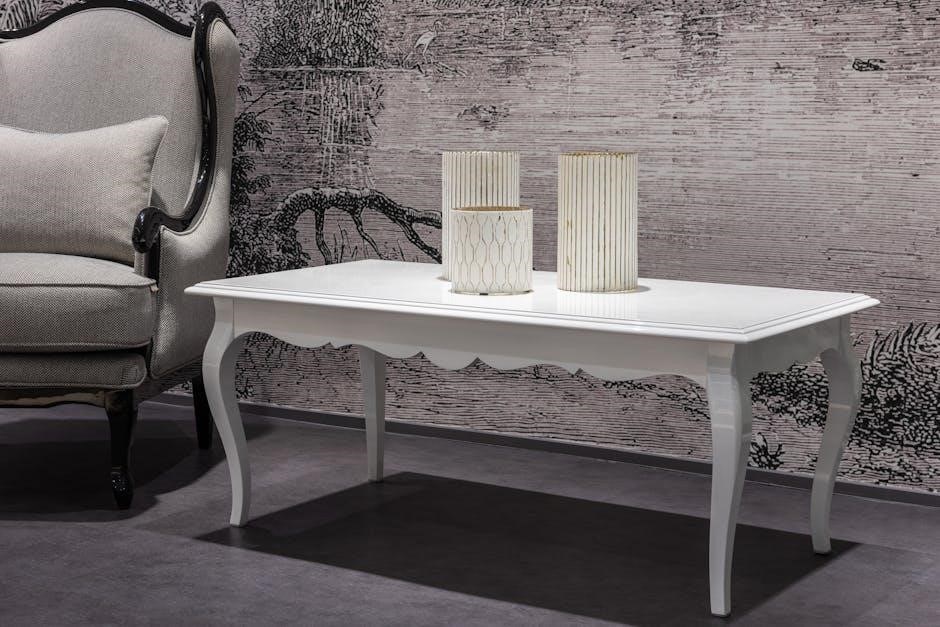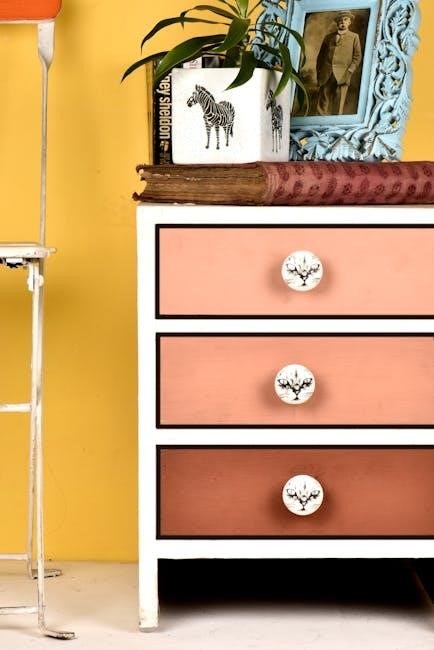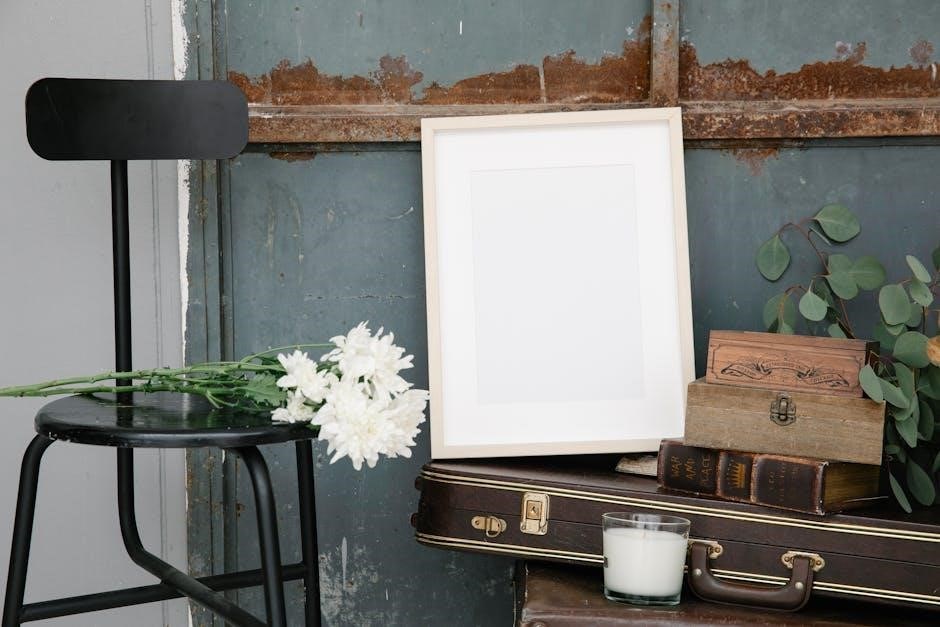Discover the art of identifying vintage and antique chairs with this essential guide․ Learn to examine design, construction, and materials to determine era, origin, and value․ Understand the differences between vintage and antique pieces, and uncover the stories behind these timeless furnishings․
1․1 Understanding the Basics of Antique and Vintage Chairs
Antique and vintage chairs are treasured for their historical significance, craftsmanship, and unique designs․ Antique chairs are typically over 100 years old, reflecting the styles of their era, such as Georgian, Victorian, or Art Nouveau․ Vintage chairs, while not as old, still offer a glimpse into past design trends, often from the mid-20th century․ Understanding the basics involves recognizing materials like oak, walnut, and maple, which were commonly used in antique furniture․ The construction techniques, such as hand-carved details or mortise and tenon joints, also distinguish antique pieces from modern reproductions․ Vintage chairs may feature simpler designs or mass-produced elements․ Knowing these differences helps collectors and enthusiasts appreciate the value and history behind each chair․ This foundational knowledge is essential for accurate identification and appraisal, ensuring that each piece is cherished for its timeless beauty and craftsmanship․
1․2 Why Identify Antique Chairs? Importance and Value
Identifying antique chairs is crucial for determining their historical significance, monetary value, and cultural importance․ Antique chairs often hold stories of craftsmanship, design evolution, and historical periods, making them valuable for collectors and historians․ Understanding their origins and styles can uncover rare pieces, such as those from the Edwardian era or Art Nouveau movement, which may be highly sought after․ Proper identification ensures authenticity, distinguishing genuine antiques from reproductions․ This process also aids in preservation, guiding restoration efforts to maintain original integrity․ For collectors, accurate identification can lead to significant financial gains, as certain styles and eras command high prices․ Beyond monetary value, identifying antique chairs connects us to the past, allowing us to appreciate the artistry and traditions of earlier craftsmanship․ Whether for personal enjoyment or investment, the ability to identify antique chairs is both rewarding and enriching․

Historical Context of Antique Chairs
Antique chairs reflect the cultural, social, and artistic movements of their time․ From Georgian elegance to Victorian opulence and Art Nouveau innovation, each era offers unique design influences and craftsmanship techniques․
2․1 Major Historical Periods in Chair Design
Antique chairs are deeply rooted in historical design periods, each with distinct characteristics․ The Georgian era (1714–1830) is known for its classical proportions and refined elegance, often featuring curved lines and tapered legs․ The Victorian period (1837–1901) brought opulence, with heavy ornamentation and intricate carvings, reflecting the Industrial Revolution’s influence․ Art Nouveau (1890–1910) introduced flowing, organic forms and sinuous lines, emphasizing natural motifs․ These periods laid the foundation for understanding chair design evolution․ Identifying the time frame helps narrow down the chair’s origin and style, making it easier to assess its value and historical significance․ By studying these eras, enthusiasts can better recognize and appreciate the craftsmanship behind each piece․
2․2 Key Design Movements: Georgian, Victorian, Art Nouveau, etc․
Key design movements significantly influence the style and craftsmanship of antique chairs․ The Georgian period (1714–1830) is characterized by classical lines, symmetry, and refined proportions, often featuring tapered legs and minimal ornamentation․ Victorian chairs (1837–1901) are more elaborate, with heavy carvings, upholstered seats, and dark, rich woods like walnut․ Art Nouveau (1890–1910) introduced flowing, organic forms and sinuous lines, often incorporating natural motifs․ Each movement reflects the cultural and artistic values of its time, making them essential for identification․ By recognizing these styles, collectors can trace a chair’s origins and era․ Understanding these design movements provides a foundation for appreciating the evolution of chair design and helps in distinguishing authentic pieces from reproductions․ These distinctive features are crucial for identifying and valuing vintage and antique chairs accurately․
2․3 Regional Influences: European, American, and Asian Styles
Regional influences play a crucial role in shaping the design and craftsmanship of antique chairs․ European styles, particularly French and English, often feature intricate carvings, ornate details, and luxurious upholstery, reflecting the opulence of their time․ American chairs, such as those from the Shaker and Colonial periods, emphasize simplicity, functionality, and clean lines, showcasing a more practical aesthetic․ Asian styles, like Chinese and Japanese designs, incorporate materials such as bamboo and lacquer, with motifs inspired by nature and cultural symbolism․ These regional differences in design, materials, and craftsmanship provide valuable clues for identifying the origin and era of a chair․ By studying these influences, collectors and enthusiasts can better appreciate the cultural heritage embedded in each piece, aiding in accurate identification and valuation․ Understanding regional styles enhances the ability to distinguish between authentic and reproduction pieces․

Design Elements for Identification
Identifying vintage and antique chairs involves examining design, materials, and craftsmanship․ Key elements include chair types, upholstery styles, wood varieties, and construction techniques, which reveal era, origin, and value․
3․1 Chair Types: Armchairs, Side Chairs, Rocking Chairs, etc․
Identifying chair types is crucial in determining their origin and value․ Armchairs, with their sturdy arms, were often reserved for formal settings, while side chairs served as versatile seating․ Rocking chairs, characterized by their curved legs, gained popularity in the Victorian era․ Each type reflects specific historical influences and functional purposes․ For instance, armchairs often featured intricate carvings and upholstered seats, signifying wealth․ Side chairs, in contrast, were simpler in design, making them accessible for everyday use․ Rocking chairs, with their signature motion, became synonymous with comfort and relaxation․ Understanding these distinctions aids in pinpointing the era and style, as well as the chair’s intended purpose, which are vital for accurate identification and valuation․
3․2 Upholstery Styles and Fabrics: A Clue to Era and Origin
Upholstery styles and fabrics provide significant clues about a chair’s era and origin․ For instance, Georgian chairs often featured luxurious fabrics like velvet and silk, while Victorian chairs embraced elaborate patterns and heavy drapery․ Art Nouveau designs incorporated flowing, organic motifs, and Mid-Century Modern chairs favored minimalist, clean-lined upholstery․ Examining the fabric’s condition, weave, and dye can reveal its age, as older materials often show signs of wear or fading․ Additionally, regional influences can be identified through specific textile traditions․ For example, Asian-inspired chairs might use intricate embroidery, whereas European designs often rely on classic damask or brocade․ The choice of fabric and its application can also indicate the chair’s intended use, whether for formal settings or everyday comfort․ By analyzing these elements, enthusiasts can narrow down the chair’s historical context and authenticity․
3․3 Wood Types: Oak, Maple, Walnut, and Their Significance
Identifying the wood type is crucial in determining the origin and era of an antique chair․ Oak, known for its strength and durability, was commonly used in medieval and Renaissance furniture․ Maple, with its light color and fine grain, became popular during the 18th and 19th centuries, especially in American pieces․ Walnut, prized for its dark, rich tone, was frequently used in high-end furniture from the 17th to the 19th centuries․ Each wood type carries historical significance, reflecting the craftsmanship and design preferences of its time․ For example, oak was favored for its robustness, while walnut signified luxury․ The grain pattern, color, and workability of the wood can also indicate the chair’s provenance․ By recognizing these characteristics, enthusiasts can better understand the chair’s historical context and value, making wood identification a vital step in the authentication process․
3․4 Construction Techniques: Dovetailing, Mortise and Tenon
Dovetailing and mortise and tenon joints are hallmark construction techniques in antique chairs, reflecting superior craftsmanship and durability․ Dovetailing, characterized by interlocking tails and pins, is often seen in drawer construction but also in chair frames, indicating handcrafted precision․ Mortise and tenon joints, where a recess (mortise) accepts a projecting tenon, were widely used for chair legs and frames, ensuring stability․ These methods, typically hand-cut, reveal the skill of the maker․ Unlike machine-made pieces, hand-cut joints often show slight irregularities, a clue to authenticity․ The presence of these techniques can help date a chair, as they were common in earlier periods․ Over time, such construction methods became less prevalent, making them a key factor in identifying genuine antiques․ Recognizing these joints aids in assessing the chair’s age, quality, and potential value, while also highlighting the craftsmanship of bygone eras․

Identification Methods
Identifying vintage and antique chairs involves examining maker’s marks, hardware, and construction techniques․ Look for dovetailing, mortise and tenon joints, and hand-carved details to determine authenticity and era․ Inspect upholstery, wood types, and proportions for clues about origin and craftsmanship․ These methods help distinguish genuine antiques from reproductions, guiding collectors and enthusiasts in understanding the chair’s history and value․
4․1 Examining Maker’s Marks and Signatures
Maker’s marks and signatures are crucial for identifying vintage and antique chairs․ These markings often reveal the chair’s creator, production date, or origin․ Look for stamps, labels, or engraved initials, typically found on the underside, back, or legs․ Some marks may include the exact year, though they can fade over time․ Research these symbols to trace the chair’s history and authenticate its age․ For instance, specific manufacturers or designers may have distinctive styles or codes․ Comparing these marks with historical records or catalogs can help verify the chair’s provenance․ While not all antique chairs bear visible marks, their absence doesn’t diminish the piece’s value․ Examining these details is a key step in unraveling the story behind a chair and determining its authenticity․
4․2 Hardware and Metalwork: Hinges, Nails, and Screws
Examining the hardware and metalwork on vintage and antique chairs can provide valuable clues about their age and authenticity․ Look for hinges, nails, and screws that are hand-forged or exhibit signs of aging, as these are often indicative of earlier craftsmanship․ Older chairs frequently feature hand-made nails with irregular heads, while later pieces may use machine-produced screws․ Metalwork such as decorative hinges or mounts can also hint at the chair’s origin and era․ For example, intricate brass hardware may suggest a high-quality, mid-century design․ Rust, patina, and wear on metal components can further confirm the chair’s age․ When inspecting, note whether the hardware appears original or has been replaced, as this can impact the chair’s value․ Pay attention to small details, like the type of screws used, to distinguish between antique and reproduction pieces․ This scrutiny helps in authenticating the chair’s historical context and craftsmanship․
4;3 Joinery and Craftsmanship: Handmade vs․ Machine-Made
Distinguishing between handmade and machine-made joinery is crucial in identifying the age and value of vintage and antique chairs․ Handmade pieces often exhibit slight imperfections, such as uneven dovetailing or manually carved joints, reflecting the craftsmanship of earlier eras․ In contrast, machine-made chairs, which became prevalent during the Industrial Revolution, feature precise, uniform joints and symmetrical patterns․ Look for signs of hand tooling, like chisel marks or uneven surfaces, which are indicative of artisanal construction․ Additionally, the type of joinery used, such as mortise and tenon or dovetailing, can offer insights into the chair’s historical context․ Machine-made chairs tend to have cleaner, more standardized joints, while handmade ones may show more character and human touch․ This distinction not only aids in dating the piece but also highlights the craftsmanship, helping to determine its authenticity and potential value․
4․4 Proportions and Ergonomics: Understanding Chair Anatomy
Examining the proportions and ergonomics of a chair is essential for understanding its design intent and historical context․ Antique and vintage chairs often reflect the ergonomic needs of their time, with proportions tailored to the average user․ Look for balanced dimensions, such as the height of the seat, depth of the backrest, and angle of the legs, which indicate functionality and comfort․ Early chairs may have steeper angles or lower seats, while later designs prioritize user comfort․ The anatomy of the chair, including elements like armrests, stretchers, and finials, can reveal its purpose and era․ Pay attention to how proportions align with known historical styles, as this can help date the piece․ Understanding these aspects not only aids in identification but also highlights the craftsmanship and design philosophy behind the chair, making it easier to distinguish genuine antiques from reproductions․
Determining the Value of Antique Chairs
The value of antique chairs is determined by factors like rarity, condition, and provenance․ Professional appraisals provide accurate assessments, while market trends reveal demand for specific styles and eras․
5․1 Factors Affecting Value: Rarity, Condition, Provenance

The value of antique chairs is significantly influenced by rarity, condition, and provenance․ Rarity refers to how uncommon the chair is, with limited production or unique designs commanding higher prices․ Condition plays a crucial role, as well-preserved chairs with original finishes, upholstery, and hardware are more valuable․ Provenance, or the chair’s history, adds prestige if it can be linked to notable owners or historical events․ Chairs in exceptional condition, with minimal repairs or wear, are highly sought after․ Additionally, the availability of documentation, such as maker’s marks or historical records, can enhance value․ Understanding these factors helps collectors and enthusiasts assess and appreciate the worth of their antique chairs, making them more informed buyers or sellers in the market․
5․2 How to Get an Antique Chair Appraised
To determine the value of an antique chair, consider consulting a professional appraiser specializing in furniture or antiques․ Start by researching reputable appraisers in your area or through online platforms․ Provide detailed photos of the chair, including close-ups of craftsmanship, hardware, and any markings․ Be prepared to share its history or provenance, if available․ Appraisers will assess factors like rarity, condition, and demand to estimate the chair’s value․ You can also contact auction houses or antique dealers for evaluations․ Additionally, some online forums and expert communities offer preliminary assessments based on photos and descriptions․ Always seek multiple opinions to ensure accuracy․ Remember, a thorough appraisal requires time and expertise, so be patient and provide as much information as possible to help the appraiser make an informed judgment․
5․3 Market Trends: What’s in Demand?
Market trends for antique chairs often reflect shifting design preferences and cultural revivals․ Currently, mid-century modern and Art Nouveau styles are highly sought after, as are pieces with unique craftsmanship or historical significance․ Chairs from the 18th and 19th centuries, such as Georgian or Victorian designs, remain popular due to their intricate details and timeless appeal․ Regional styles, like French Louis XVI or Scandinavian designs, also attract collectors․ Sustainability trends have increased demand for antique furniture as eco-conscious buyers opt for vintage over new․ Upholstered chairs with original fabrics or high-quality reupholstery are particularly desirable․ Additionally, chairs with provenance or ties to notable designers or historical figures command premium prices․ Understanding these trends can help collectors and sellers navigate the market effectively, ensuring they target the right audience for their pieces․
5․4 Red Flags: Reproductions and Fakes
When identifying antique chairs, it’s crucial to recognize red flags that indicate reproductions or fakes․ One common sign is mismatched hardware, such as modern screws or hinges on an otherwise old chair․ Perfect or overly uniform finishes may also suggest a reproduction, as genuine antiques often show wear and patina․ Look for synthetic materials masquerading as natural wood or fabric, as these are giveaways of modern construction․ Additionally, chairs with inconsistent styling or proportions compared to their claimed era should raise suspicions․ Over-restoration or excessively polished surfaces can erase signs of age, making it harder to verify authenticity․ Finally, lack of maker’s marks or unclear provenance can indicate a fake․ Always consult an expert if unsure, as distinguishing genuine antiques from reproductions requires careful examination and expertise․

Care and Maintenance of Antique Chairs
Regularly inspect hardware and joints for stability․ Address loose parts promptly․ For intricate repairs, consult a professional to preserve craftsmanship and avoid further damage to valuable pieces;

6․1 Cleaning and Preserving Antique Wood Finishes
Cleaning and preserving the wood finishes on antique chairs requires gentle care․ Always use soft, dry cloths to remove dust, avoiding harsh chemicals that might damage the finish․ For more thorough cleaning, consider using a mild soap solution, but test it first on an inconspicuous area to ensure it doesn’t harm the wood or its finish․ Avoid using wax or polishes, as they can build up over time and obscure the original finish․ Instead, opt for a furniture oil that nourishes the wood without leaving a residue․ Regular maintenance helps maintain the integrity and beauty of the wood, preserving it for future generations․ Remember, the goal is to protect the chair’s original patina, which is a key factor in its value and historical significance․
6․2 Repairing Damaged Chairs: When to DIY and When to Call a Professional
Repairing a damaged antique chair requires careful consideration to preserve its value and integrity․ Minor issues, such as tightening loose joints or replacing worn upholstery, can often be handled with DIY techniques․ However, more complex repairs, like restructuring a broken frame or restoring intricate carvings, typically require the expertise of a professional conservator or restorer․ DIY repairs can risk further damage if not done correctly, especially with valuable or historically significant pieces․ Avoid using modern materials like glue or screws, as they can compromise the chair’s authenticity․ For major restorations, seek a skilled craftsman who specializes in antique furniture․ Remember, improper repairs can devalue the chair, so it’s crucial to weigh the risks and benefits before attempting any work․ Always prioritize preserving the original craftsmanship and materials to maintain the chair’s historical and monetary worth․
6․3 Storing Antique Chairs: Tips for Long-Term Preservation
Proper storage is essential for preserving the condition and value of antique chairs․ Keep them in a cool, dry environment, away from direct sunlight to prevent fading or warping․ Avoid basements or attics prone to moisture, as humidity can damage wood and upholstery․ Use breathable covers like cotton or muslin to protect against dust, but avoid plastic, which can trap moisture․ If stacking is necessary, place chairs on sturdy, padded surfaces to prevent scratches․ Ensure the storage area is pest-free, as insects can harm wood and fabric․ For long-term storage, consider disassembling chairs if possible, but only if you can reassemble them without damage․ Regularly inspect stored chairs to catch and address any issues early․ By following these tips, you can ensure your antique chairs remain in excellent condition for future generations to appreciate and enjoy․

Mastering vintage antique chair identification involves understanding historical styles, construction, and markings․ This guide has equipped you with essential knowledge to embark on your collecting and learning journey․
7․1 Summing Up the Key Points for Identification
Identifying vintage and antique chairs requires a systematic approach․ Start by examining the overall design, including the chair type, upholstery, and wood species used․ Look for historical influences, such as Georgian, Victorian, or Art Nouveau styles, and note regional differences in European, American, or Asian designs․ Inspect construction techniques like dovetailing, mortise, and tenon joints, which indicate craftsmanship and era․ Seek maker’s marks or signatures, as these can provide direct evidence of origin and date․ Analyze hardware and joinery to distinguish handmade pieces from machine-made reproductions․ Understanding proportions, ergonomics, and materials will also aid in dating the chair․ Finally, consider the chair’s condition, rarity, and provenance to assess its value․ By combining these elements, enthusiasts can confidently identify and appreciate vintage and antique chairs, separating genuine antiques from modern replicas․
7․2 Encouragement to Continue Learning and Collecting
Embark on the rewarding journey of collecting and learning about vintage and antique chairs․ Each piece tells a story, offering insights into history, design, and craftsmanship․ As you explore, refine your skills by studying historical periods, design movements, and regional influences․ Engage with communities of collectors and experts to share knowledge and gain insights․ Attend auctions, visit antique shops, and participate in workshops to deepen your understanding․ Remember, identifying and collecting antique chairs is a lifelong passion that combines art, history, and personal satisfaction․ With dedication, you’ll uncover rare gems and build a meaningful collection․ Keep learning, stay curious, and enjoy the thrill of discovering the past through these timeless pieces of furniture․



